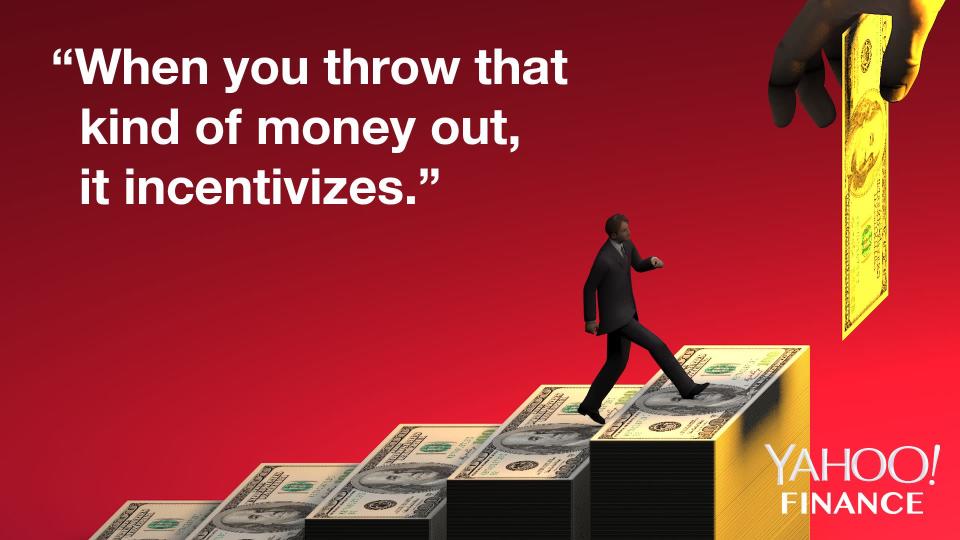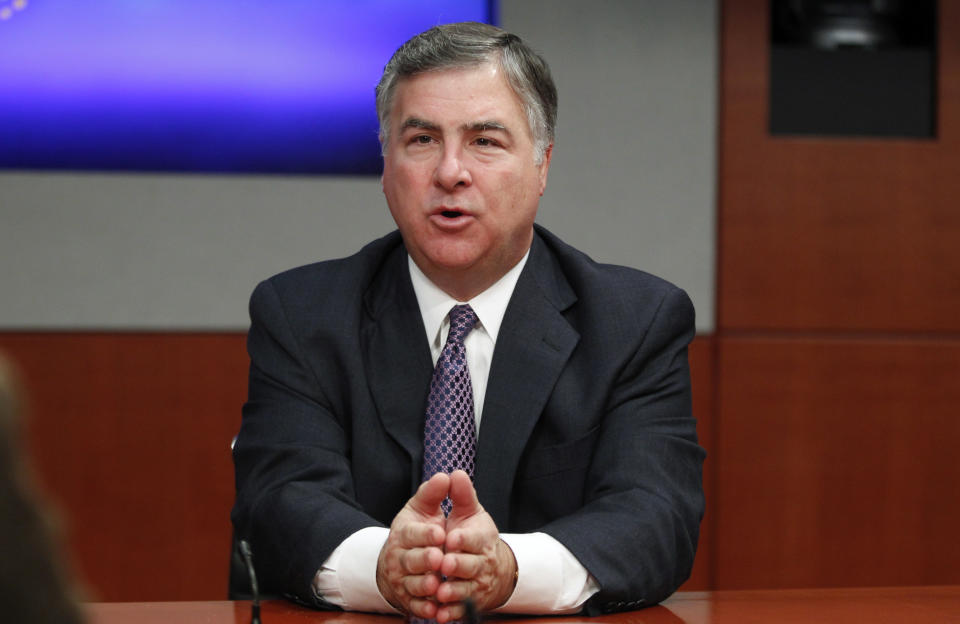Wells Fargo's bonuses were 'bad business on steroids': former executive

It was over two years ago that Wells Fargo’s fake accounts scandal burst into the headlines, and since then, there has been an unrelenting torrent of bad news. In late October, the American Banker reported that two executives were placed on leave after they received notifications of pending sanctions from the Office of the Comptroller of the Currency. In November, Federal Reserve chairman Jerome Powell sent a letter to Senator Elizabeth Warren saying the Fed will not lift a cap on Wells’s growth until the bank addresses deficiencies in oversight and risk management. “The underlying problem at the firm was a strategy that prioritized growth without ensuring that risks were managed, and as a result the firm harmed many of its customers,” Powell wrote.
In early November, Jay Welker, who was the head of the private bank, which sits within the bank’s wealth management business, retired. Under Welker, the private bank pushed wealth advisors to vigorously sell high-fee products. There may be more bad news about this aspect of the embattled bank. The Justice Department, the SEC, the Labor Department, and Wells Fargo’s own board are conducting ongoing investigations into its wealth management business that have yet to be resolved.
There’s still one aspect of how the wealth management business pushed for growth that former Wells Fargo employees say hasn’t gotten the scrutiny it should. For four years, starting in 2012 and through the end of 2015, Wells incentivized some of its advisors in that business through something called the “Growth Award.” Some former employees say these awards led to behavior that was not in the best interest of clients, including steering them towards higher-fee products. The Growth Award was much discussed internally, says a former investment strategist at Wells, although not everyone was privy to the details of how it worked.
Last summer, the Wall Street Journal reported the existence of the growth award, but not the details of how the money worked. Essentially, the growth award was a way of motivating advisors to grow their businesses. In and of itself, that isn’t unusual. The industry has for years offered successful brokers incentives, often in the form of elaborate trips to exotic locales.The SEC is weighing new rules that may curtail the use of such rewards under the theory that they could make brokers “predominantly motivated” by “self enrichment.” Firms have also long used rich packages to lure successful brokers to move their business.

But firms are cutting back on the use of such packages, according to industry insiders. When told about the details of the growth award, three financial advisors at other firms with whom Yahoo Finance spoke expressed shock at both the sheer size and the way it incentivized advisors for short-term growth, rather than long-term business building. (Another advisor thought that in the context of the packages that were used to incentivize brokers to switch, it wasn’t so surprising.) Or as former Wells Fargo executive, who was in the retail brokerage industry for decades, says, “If a free golf outing is bad business, then the Growth Award is bad business on steroids.”
In a statement to Yahoo Finance, spokesperson Shea Leordeanu said, “At Wells Fargo Wealth and Investment Management, we are committed to taking care of our clients’ financial needs every day and take seriously our responsibility to help them preserve and invest their hard-earned savings. Our primary goal is to be a trusted advisor to our clients and to act in their best interests. And we have supervisory processes and controls in place so that, if a team member acts in a manner not in line with our values and our policies, we take appropriate action.”
An enormous, compounding bonus for bringing revenue to Wells Fargo
The Growth Award wasn’t available to the entire army of some 14,000 advisors, who make up the broad group of Wells Fargo Advisors. (Many others, most prominently those who came with the 2008 Wachovia merger, had different compensation plans with lock-ups that are just now expiring, leading to something of an exodus, according to press reports.) This Growth Award, on the other hand, was meant for the 3,000 or so advisors who were part of something known as Wealth Brokerage Services, or WBS. These advisors are located in the bank branches, or in hubs—Wells Fargo buildings in cities—that housed wealth management personnel among others like business bankers. (Wells Fargo subsequently announced a reorganization that is expected to combine what were separate groups of advisors.) To be eligible, you couldn’t be a newbie — you needed a two year minimum at the bank — and you had to be doing more than $350,000 in annual revenue. The former executive and another advisor estimate that narrowed the group down to about 2,000 people.
The amounts people stood to make were extraordinary. Here’s how the math worked. The goal was for an individual financial advisor to increase his or her revenue by at least 15% for each of the four years that the Growth Award was in place. The award multiplied each year the goal was achieved. So if you achieved 15% growth in the first year, you received a 15% bonus. If you achieved 15% growth again in the second year, you received a 30% bonus. If you achieved 15% growth in the third year, you received a 45% bonus. Finally, if you achieved 15% growth again in the 4th year, you received a whopping 60% bonus.
If you didn’t achieve the goal, you were not penalized, but you didn’t receive the bonus.

To get specific about just what these percentages could mean, say you generated $1 million in revenue in 2011, and you achieved precisely 15% growth each year for the next 4 years. In year one, your revenue would be $1,150,000, and your bonus, at 15% of that, would be $172,500. The new 2013 goal would be $1,322,500 (a 15% increase from the $1,150,000.). If you hit that goal, your Growth Award bonus for 2013 would be $396,393. And so on. If you hit the goals for 2014 and 2015, you stood to make a bonus of $684,393 and $1,049,403, respectively. That means you stood to make $2.3 million in total Growth Award bonuses. In other words, the financial incentives to hit the numbers were enormous.
Perhaps for the very reason the incentives were so enormous, more advisors hit the numbers than Wells had expected. (Of course, there was also a strong bull market during that period.) The Journal reported that Wells had allotted $250 million for the Growth Award bonuses. Instead, Wells had to pay $750 million between 2012 and 2015. “It’s widely known inside Wells that they were so way over budget,” says another former advisor. “I personally know brokers who were awarded bonuses of over $2 million, which is a stunning amount of money,” says a former investment advisor.
Roughly two-thirds of the 2,000 or so eligible advisors earned an award.
“When you throw that kind of money out, it incentivizes.”
Now consider the Growth Award from the perspective of a client, who might wander into a bank branch, maybe having gotten an unexpected inheritance. “You have to connect the dots,” the former executive says. “This is where the sales pressure in the bank branches meets the wealth and investment management business.”
The staff of the branch was incentivized to steer clients to a Wells financial advisor, because investment management referrals helped them meet their sales goals, and that advisor, in turn had incentives — really big incentives — to steer the clients toward products that generate upfront revenue. “If you don’t have a high moral background, it’ll put you in a position to do things for clients that aren’t in their best interest,” says a former advisor. “I’m always looking at what’s best for the client but it's also what’s best for my paycheck.” “You are absolutely incentivizing advisors to sell the products with the highest upfront fees,” says the former executive.
“Yeah, when you throw that kind of money out, it incentivizes,” says another former advisor. “Jesus would probably be okay. But the disciples probably would have had some morals put to the test on that one.”
Multiple sources say the Growth Award helps explain why annuity sales at Wells Fargo were so high, especially after the bank tried to tamp down on the amount the Award was going to cost them. In 2014, Wells Fargo decided to stop “fee fronting,” which allowed advisors to count fees that would be paid in subsequent years toward their annual tally. So advisors began to search for products with high initial fees, one former advisor said.
Annuities come with high upfront revenues for the broker, making them an obvious choice for someone who is trying to hit a revenue target — but maybe not the optimal choice for the client. “You think Wells Fargo’s Bankers Are Bad? Take a Look at its Brokers,” was the headline of an October 2016 piece in thestreet.com. The piece noted that Wells had argued to the Securities and Exchange Commission that it should not be subject to rules to put its investors first in cases where its advisors were making referrals for products including annuities, and that in 2015, Wells was number one in the country for annuity sales.
“It’s pretty stunning that a firm that has just half the assets of its larger competitors sells more annuities,” says a former advisor. “I think that just speaks to the emphasis on making sales numbers and a need to sell more of the highest payout products.” Indeed, the Journal reported and several former advisors corroborate that internally, 2015 was dubbed “The Year of the Annuity.”
It wasn’t just annuities. One former advisor also noted that advisors trying to chase the growth award also favored mutual funds with high upfront fees. “You'd think if revenue was going up by 15% a year, your AUM would at least go up at least 12% or 13%,” a former advisor said. “That was not the case. The award was only revenue based — there was nothing in there for AUM, longevity, or anything like that. Strictly show us the money and we'll show you the money.”
All the fees were disclosed to Wells Fargo’s clients. But what clients didn’t know was the incentive structure that was in place for their advisor. So yes, clients understood the fees — but they were in the dark as to at least part of the reason one product might have been recommended over another. “Imagine that it’s November,” says the former executive. “You have to do $250,000 in revenue, or you going to leave a million dollars on the table. What are you doing to do?” He continues, “Every client of WBS has to go back and look at every trade, every single decision, from 2012 to 2015 and scrutinize whether it was impacted by the Growth Award.” “I think if clients and the public knew that Wells Fargo Advisors had given such substantial and amazing well-timed retention bonuses to lock up their advisors, they would begin to wonder whether their advisors were giving the best advice to their clients,” says another former investment strategist.
There could be another problem, too. “If you achieved the goal early, you would stop doing business so you didn’t have the higher base to start from in the next year,” says the former executive. “You’d sand bag — and that might not be in the client’s best interest either.”
A golden handcuff at a very good time for Wells Fargo
The Growth Award may also help explain why Wells has been able to retain as many advisors as it has, despite the ongoing scandals. Six months before the end of the Growth Award program, midway through 2015, Wells Fargo asked those advisors who had qualified for the award how they would like to receive their pay. There were two options. The first option essentially allowed the advisor to unlock all the money at the end of February 2021. If the advisor left before that, the money was forfeited. A third of the advisors who earned awards chose this option.
The other option paid out a tenth of the bonus each year for 10 years. If the advisor so chose, they could get that money up front as a forgivable loan. Every year the advisor remained at Wells Fargo, he or she would simply pay the interest on their bonus, and a tenth of the principle would be forgiven. But if the advisor left, he or she had to pay back the unforgiven principle. (Or if the advisor hadn’t taken the forgivable loan, the annual checks would stop.) Two-thirds of advisors opted for this route.
The Growth Award also had the potential to create another problem for advisors. The nice thing about building a fee-based business is that it’s an annuity for the advisor. Every year, there’s a fee. If, on the other hand, the advisors put clients’ money into things that generate a one-time pop of revenue, the advisor doesn’t get the same type of ongoing fees. So, the former executive says, some advisors are in a hole, where they owe taxes on the Growth Award, while their income has shrunk dramatically. “I know guys who got it who built or bought a huge house and are now stuck,” he says.
The golden handcuff of the Growth Award has been good for the bank in the face of all of the scandals. One advisor told Yahoo Finance that the growth in the number of clients also shrank dramatically amid the unrelenting negative news.
“I went from around 30 referrals to two in six months after the scandal hit,” this person said. What had been a solid stream of clients slowed to a trickle. But the only out for advisors would have been to have another firm hire them away and pay off their loan.
Perhaps the most interesting thing about the Growth Award is how deliberate it was. “It was not a computer glitch or an oversight,” as the former executive says. “It was not perpetrated by a few rogue employees. The Growth Award was conceived by the Compensation Committee. The Compensation Committee is the most senior of senior management. The goal was to drive growth and drive growth it did.” But perhaps at a price for clients—making the Growth Award, in its way, the most telling evidence yet of the cultural issues within Wells Fargo.
Read more:
Exclusive: Wells Fargo pushed wealth advisors to use high-fee products, cross-sell
Exclusive: Wells Fargo automated high-net-worth wealth management as advisors faced sales pressure
Every Wells Fargo consumer scandal since 2015: a timeline
Wells Fargo’s scandals just won’t die
Bethany McLean is a contributing editor at Vanity Fair and bestselling author. Her latest book, “Saudi America: The Truth About Fracking and How It’s Changing the World,” came out in September 2018.
Ethan Wolff-Mann is a senior writer at Yahoo Finance focusing on consumer issues, tech, and personal finance. Follow him on Twitter @ewolffmann. You can contact him at [email protected].